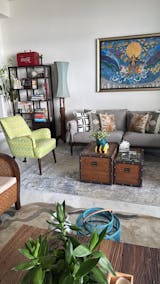"As we motorbike past, an old lady catches my eye. Her pink dress matches her house, plants and flowers. To me, one of the best ways to understand a culture you travel to is by entering a home. I am overjoyed when the lady invites me in. So is she. Speaking excitedly in Portuguese, she goes through her box of things and shows me a photo of her younger self pretty in pink. Even her plastic cups and tablecloth are a worn-out dusty pink."
- Denise Taojo Kaur, Founder of Living DNA
Hordes flock to Goa for its beach party scene. But beyond the intoxication are quiet pockets of heritage where home is a statement and a traditional Portuguese craft literally tells your identity. Join us as we ride through the streets of the old Portuguese quarters of Panjim and discover the colonial houses of Goa.
A coloured home stood for economic well-being, though it's not entirely a matter of choice. During the Portuguese occupation, you can be fined if your house was not painted.
I must have stepped into a colouring book. Every single house in Goa is washed in vibrant paint. They seem to have a knack for white accents. There is an unspoken Portuguese rule that only churches can be painted white, so the colour of purity became sought after. Siesta time is the perfect time to walk around Panjim. The streets are deserted. Through the window you see glimpses of the residents unguarded.
Goa's culture is something close to home: Portuguese-occupied, largely Catholic, on a tropical coast. When such seeds fall into the soil as old as mankind, the result is a heritage unlike any. Some things remind me of my grandparents' house in the Philippines, like wrought iron grilles. A layering of cultures: Behind the wrought-iron grilles are Chinese and Indian paintings. Beautiful azulejo tiles are ubiquitous in Portugal. Ornate applications can be found in the Sao Bento Railway Station in Porto and many stops in the Lisbon metro. In this Portuguese colony, the azulejo application is humbler yet holds its own charm.

The word 'azulejo' comes from Arabic roots, meaning 'small polished stone'. Originally they were fairly simple structures cut into geometric shapes in neutral tones. It wasn't until Portugal's King Manuel I visited Seville and brought the idea back, that Portugal truly adopted this artwork into its culture. The tiles were used to cover up the large areas of blank wall that were common inside buildings during the Gothic period.
Antique azulejos were decorated in a simple colour palette, dominated by blues and whites. It is believed that these colours were influenced by the Age of Discoveries (15th - 18th centuries) and considered fashionable at the time. The other colours that appeared were yellow (sometimes looking gold) and green. Today, azulejos are a dominant feature in every Portuguese city and can be seen in the colonies such as Goa where it is mainly used as nameplates for every family's home.




Between slightly open doors, one can see home interiors with images of the Sacred Heart of Jesus, Immaculate Heart of Mary and statues of Catholic saints. Interiors are much simpler than the striking interior. In the next blog, we explore the interiors of the Braganza family home, observing their furniture and furnishing.
















